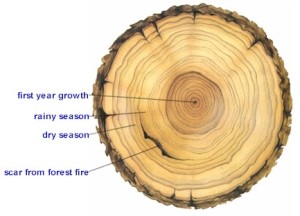By Penny Paugh
One form of environmental data, tree rings, has provided evidence of a climate shift that, perhaps not coincidentally, occurred from 250 to 550 A.D., a period that coincides with the fall of the Roman Empire. From ancient wood found in medieval castles and Roman ruins, the Swiss Federal Institute for Forest, Snow, and Landscape Research created a rough history of climate change over the past 2.5 millennia. From the tree rings, the scientists could tell how warm and wet the weather had been. A thick ring occurs in times of good climate, and a narrow ring occurs in years of drought or extreme temperatures.

An example cross-section of a tree trunk that provides valuable insight into historical weather. Image reproduced from Maricopa.edu.
The study showed that there was an abnormal amount of variability in the climate during that period but does not point to its causes. Possible causes could have been volcanic activity, solar variability, or even standard variability of the climate system. While inconclusive, the study still provides beneficial data for scientists sleuthing their way into an uncertain climate future.
Reference
NPR Staff (January 22, 2011). Could Climate Change Have Led to The Fall of Rome? Retrieved from: <http://www.npr.org/2011/01/22/133143758/could-climate-change-have-led-to-the-fall-of-rome>.

Comments are closed.